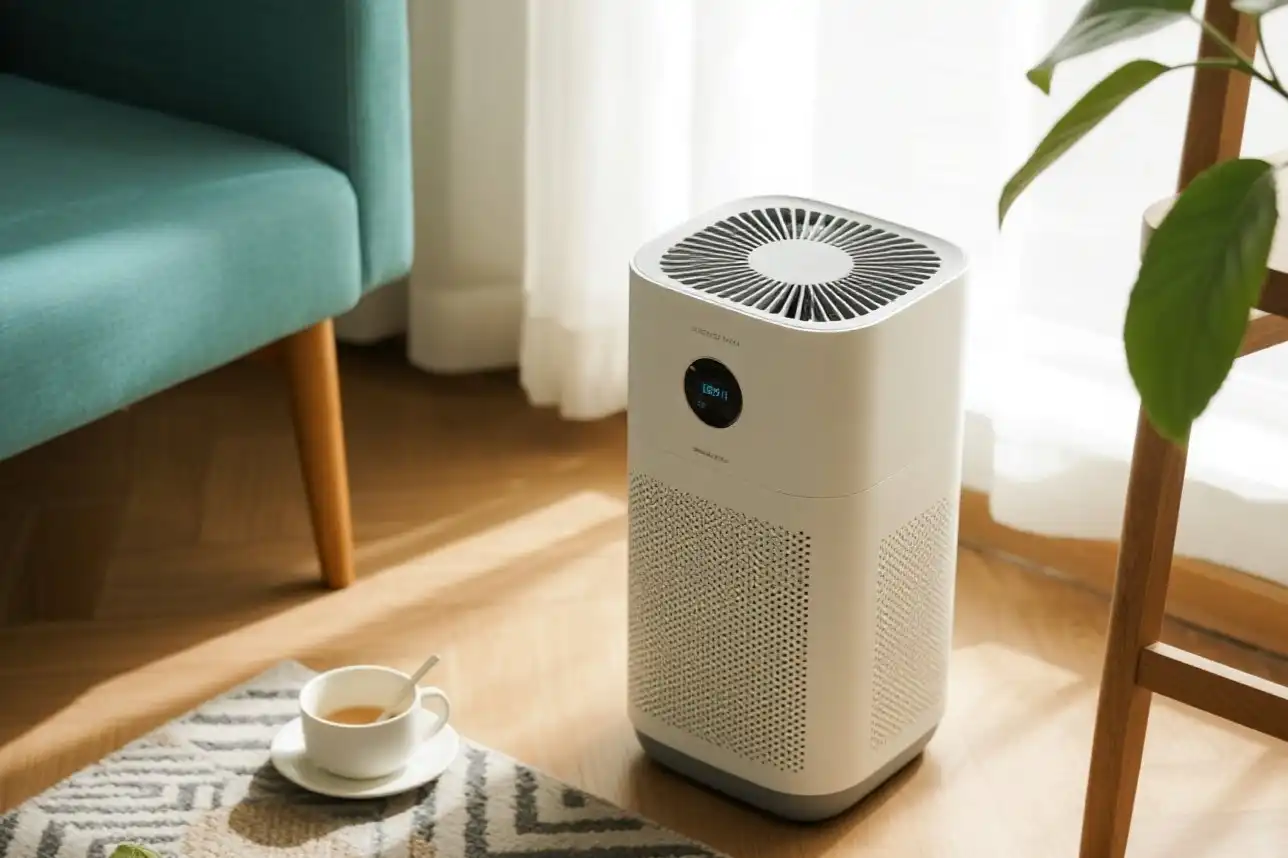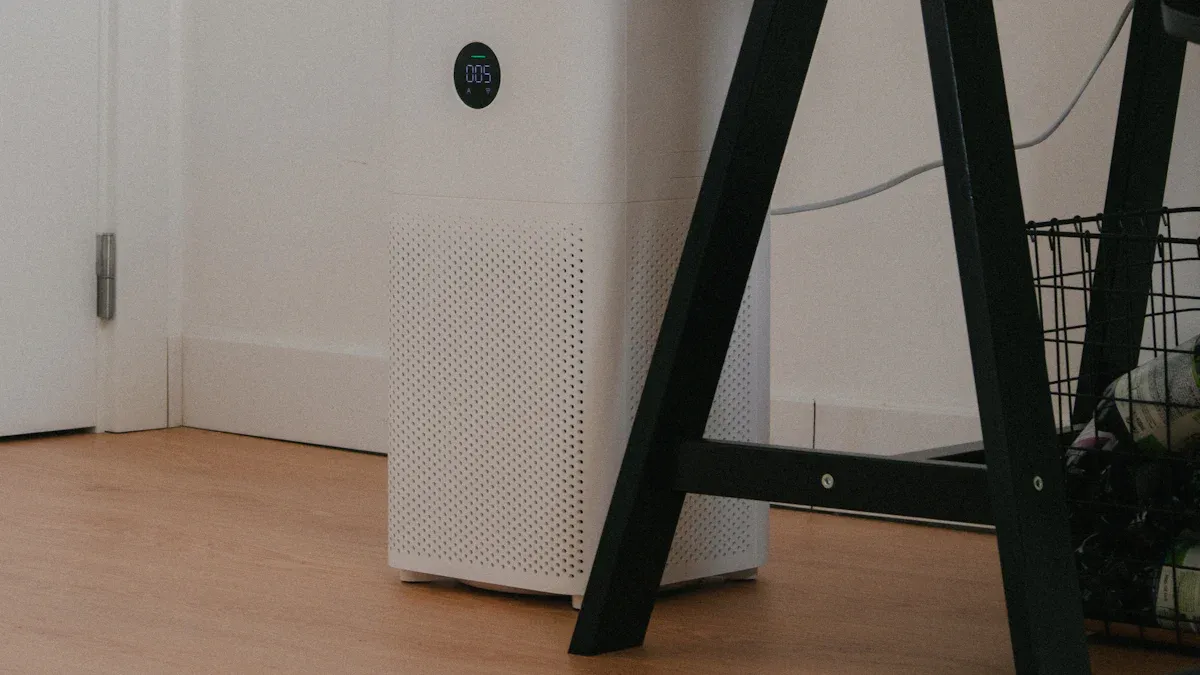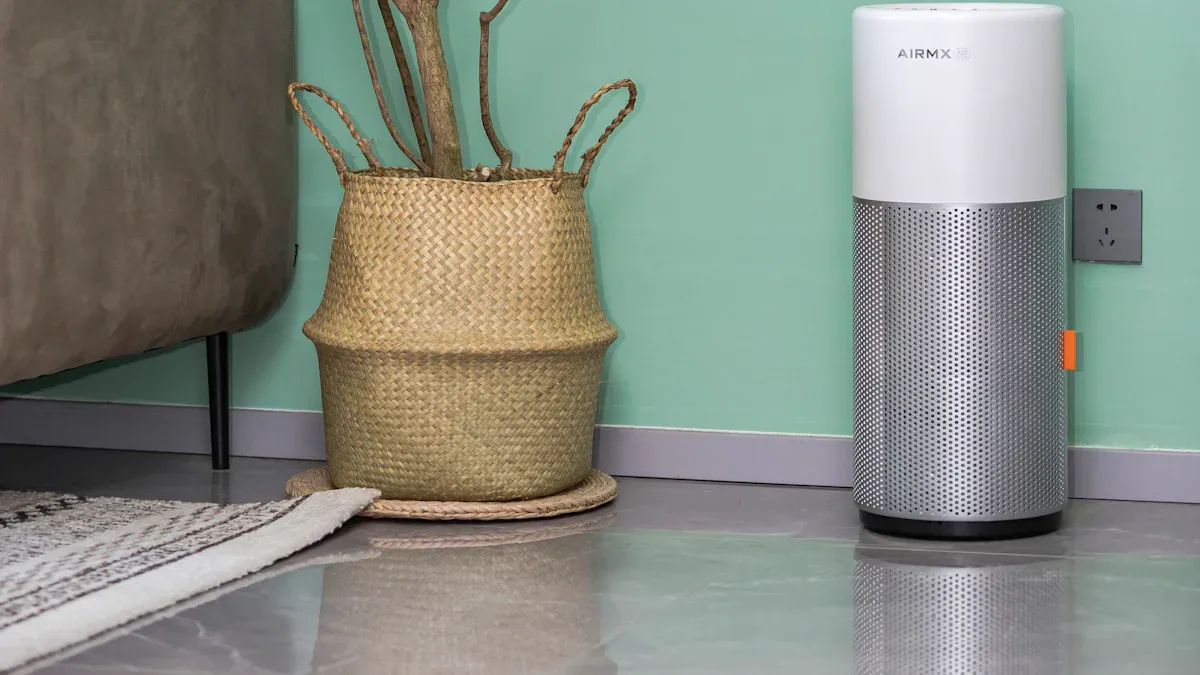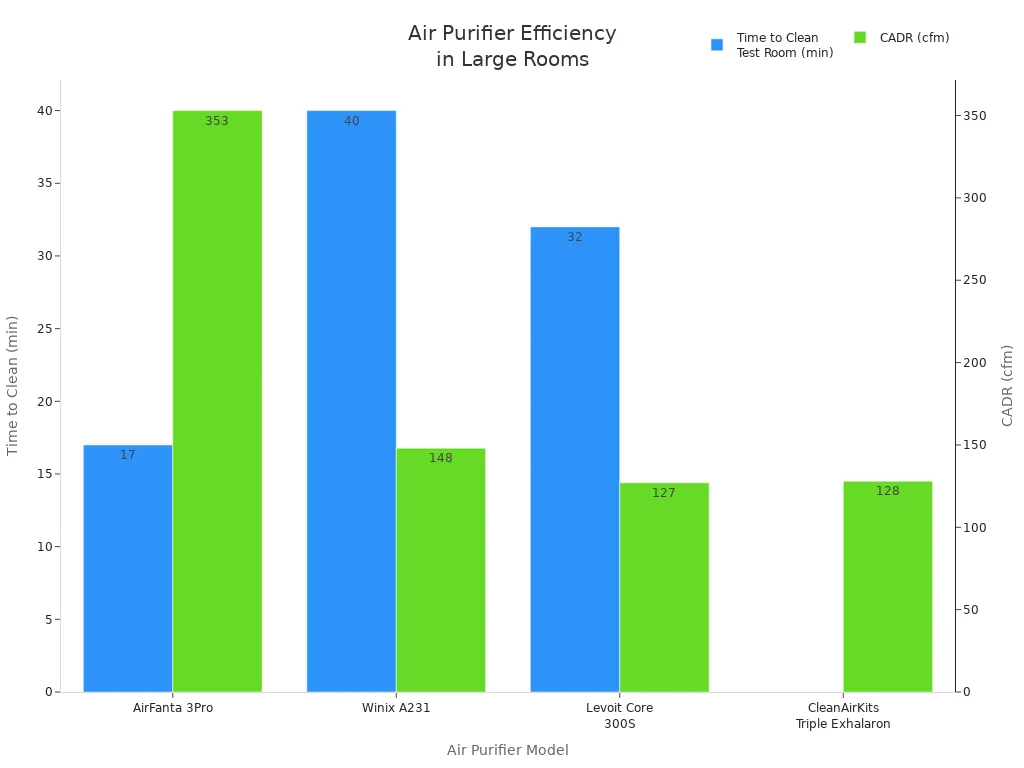
Many people make simple mistakes with the location of air purifier placement. You might put your air purifier too close to walls, hide it behind furniture, or set it in a corner. Some people place it near windows or on shaky surfaces. These choices can block airflow and lower how well your air purifier works. Check your current setup and see if you need to make a small change for better air quality at home.
Key Takeaways
- Put your air purifier in open areas. Keep it away from walls, furniture, and corners. This helps air move freely and makes cleaning better.
- Place your air purifier close to pollution sources. These can be kitchens or places where pets stay. It will catch bad stuff fast and clean the air you breathe.
- Set your air purifier at breathing height. This is about 3 to 5 feet above the floor. It will catch more dust and allergens this way.
- Do not put your air purifier in rooms you do not use. Keep it away from windows, doors, or shaky surfaces. This keeps it safe and helps it work better.
- Make sure your air purifier fits your room size. A small purifier will not clean a big room well. Check the Clean Air Delivery Rate (CADR) before you buy one.
Blocked Airflow

Too Close to Walls
When you place your air purifier too close to a wall, you block the flow of air. This mistake can lower the machine’s ability to clean your room. You want your purifier to pull in dirty air and push out clean air. If you put it right next to a wall, it cannot do this well.
- Placing an air purifier near a wall or in a corner restricts airflow and reduces how much air the purifier can process.
- You should keep at least 6 to 12 inches of space between the purifier and any wall or large object.
- Proper placement can make your air purifier up to 2.5 times more effective.
- Avoid corners, as they block both the intake and the exhaust.
- A central spot in the room helps the purifier reach more air.
Tip: Place your air purifier on a hard, flat surface and keep it about three feet off the ground. This position helps the machine capture airborne dust and pollen more easily.
Behind Furniture
Putting your air purifier behind furniture is another common mistake. When you hide the purifier behind a couch or curtain, you block the air from moving freely. The purifier cannot pull in dirty air or push out clean air if something stands in the way.
- Air purifiers need open space to work well. Furniture blocks the intake and output, making the purifier less effective.
- You should avoid placing the purifier behind sofas, chairs, or curtains.
- Keep about three feet of clear space around the purifier for the best results.
- Obstructions like furniture or shelves can trap clean air and stop it from spreading through the room.
Note: Always check that nothing blocks the sides or top of your air purifier. Open space means cleaner air for you and your family.
Wrong Room or Area
Far from Pollution Sources
Do not put your air purifier far from pollution sources. If you place it away from dust, smoke, or odors, it cannot catch them fast. Pollutants might spread or settle before the purifier can trap them. This mistake makes your home’s air less clean and wastes what the purifier can do.
- Air purifiers work best when they are close to pollution sources like kitchens, pet spots, or places where people smoke.
- If you put the purifier in a spot that is out of the way, airflow drops and the device cannot clean the air well.
- Pollutants build up in still air. If the purifier is far from these places, it misses the chance to catch them.
- For best results, keep the purifier between you and the pollution source. In a bedroom, put it near your bed to clean the air you breathe at night.
Tip: Put your air purifier near stoves, trash cans, or fireplaces. This helps it catch bad stuff right away and gives you cleaner air faster.
Unused Spaces
Do not put your air purifier in empty or unused rooms. If you set it up where people do not go often, it cannot help the air where you need it most. The purifier works best in busy areas or where bad air comes in.
| Placement Area | Purpose and Effectiveness | Additional Notes |
|---|---|---|
| High-Traffic Areas | Catches pollutants at entry points and keeps more out of your home. | Keep away from walls and things that block airflow. |
| Low-Traffic/Unused | Does not help the air where you spend time. | Move it to busy rooms for better results. |
Put your air purifier in rooms where you and your family spend lots of time. Living rooms, bedrooms, and kitchens are good spots. Do not use closets, storage rooms, or empty corners. This way, you make sure the air you breathe is as clean as possible.
Bad Location of Air Purifier Placement

Choosing the right location of air purifier placement is important for clean air in your home. Some spots can make your purifier work less well. You should know what to avoid so you get the best results.
In Corners
Corners might seem like a good spot, but they are one of the worst choices for the location of air purifier placement. When you put your purifier in a corner, you block the airflow on two sides. This makes it hard for the machine to pull in dirty air and push out clean air.
- Corners create “shadow zones” where air does not move much.
- A 2023 smoke test showed that corners can lower cleaning power by up to 63%.
- Stagnant air in corners can have pollution levels up to 30 times higher than open areas.
- The Clean Air Delivery Rate (CADR) drops by 40-50% in corners.
You should always keep at least 2-4 feet of open space around your purifier. This helps the air move freely and lets the purifier clean more of your room.
Tip: Place your purifier away from corners and angle it toward the center of the room for better coverage.
Near Windows or Doors
The location of air purifier placement near windows or doors can cause problems. Open windows and doors let in outdoor air, which changes the temperature and humidity inside. These changes can confuse your purifier’s sensors and make it work less well.
When you put your purifier near a window or door, you also risk letting in more dust, pollen, and pollution from outside. The purifier may have to work harder and still not keep up. The EPA says that natural ventilation from windows and doors affects indoor air quality and can lower the purifier’s performance.
Note: Keep your air purifier away from drafts and busy doorways. This helps it clean the air you breathe, not just the air coming in from outside.
On Unstable Surfaces
The location of air purifier placement on an unstable surface is risky. If you put your purifier on a wobbly table or uneven floor, it might tip over. This can damage the machine and even cause safety problems. An unstable surface can also block the air intake or exhaust, making the purifier less effective.
Manufacturers recommend placing your purifier on a flat, stable surface. You can use a hardboard or mat if you have carpet. Always follow the instructions for your model to get the best results.
| Good Placement | Bad Placement |
|---|---|
| Flat, stable floor | Wobbly table |
| Center of the room | In a corner |
| Away from windows/doors | Next to a draft |
The right location of air purifier placement helps your device last longer and keeps your air cleaner.
Alert: Never put your air purifier near water or heat sources. This can cause electrical hazards and shorten the life of your machine.
Choosing the best location of air purifier placement means avoiding corners, drafts, and unstable surfaces. When you pick the right spot, you help your purifier do its job and keep your home’s air fresh.
Wrong Height
Too High
Placing your air purifier too high can lower its ability to clean the air you breathe. Most airborne particles, like dust and allergens, gather between 3 to 5 feet above the ground. This area matches where your nose and mouth are when you stand or sit. If you put your air purifier above this level, it may miss many of the particles floating in your breathing zone.
- Air purifiers work best at breathing height, which is around the average person’s nose or mouth.
- For smoke and cooking odors, a slightly higher spot can help, since these particles rise.
- Manufacturers recommend placing the purifier 3 to 5 feet above the ground for dust and heavier particles.
Tip: Keep your air purifier at the same height as your head when you sit or stand in the room. This helps it catch the most pollutants.
If you place your purifier too high, it moves away from the area where most contaminants float. This mistake can make the purifier less effective, even if it has strong airflow. You want the device to clean the air you actually breathe, not just the air near the ceiling.
Too Low
Setting your air purifier too low, such as directly on the floor, also causes problems. Air near the floor often stays still and can hold more pollutants. When you put the purifier too low, it cannot move air well or spread clean air throughout the room.
- Dust and smoke settle lower, but a purifier on the floor cannot reach the whole room.
- Air circulation drops when the purifier sits too low, which means less clean air for you.
- In rooms where people stand, 4 to 5 feet off the ground works best. In sitting rooms, 2 to 3 feet is better.
Note: Elevate your air purifier on a table or shelf to match your breathing zone. This simple step improves air movement and cleaning power.
A purifier placed too low may also get clogged with hair and dirt from the floor. You should always keep it off the ground and away fromcorners or under furniture. This way, you help the purifier reach more air and remove more pollutants.
| Height Placement | Effectiveness for Air Cleaning |
|---|---|
| 3-5 feet above floor | Best for dust, allergens, and general use |
| On the floor | Poor air circulation, less effective |
| Above head height | Misses most airborne particles |
Choosing the right height for your air purifier helps you get the cleanest air possible in your home.
Ignoring Room Size
Small Purifier in Large Room
You might think any air purifier will work in any room, but size matters. Using a small air purifier in a large room leads to poor air cleaning. The device cannot move enough air to keep up with the space. This means dust, pollen, and other pollutants stay in the air longer.
| Air Purifier Model | Max Room Size (sq. ft.) | CADR (cfm) | Time to Clean (min) | Key Insight |
|---|---|---|---|---|
| AirFanta 3Pro | 529 | 353 | 17 | Fast cleaning for medium rooms |
| Winix A231 | 231 | 148 | 40 | Slower in larger spaces, more noise at high speeds |
| Levoit Core 300S | 163 | 127 | 32 | Best for small rooms, not effective in large spaces |
| CleanAirKits Triple Exhalaron | 192 | 128 | N/A | Quiet, but only for small rooms |
A small purifier in a big room cannot provide enough air changes per hour. You may notice the air still feels stuffy or smells linger. The Clean Air Delivery Rate (CADR) helps you match the purifier to your room. For best results, choose a purifier with a CADR that is about two-thirds of your room’s square footage. For example, a 200-square-foot room needs a CADR of at least 133.

Tip: Always check your room size before buying a purifier. Using multiple small units can help in large or oddly shaped spaces.
Poor Airflow Patterns
Ignoring airflow patterns can make your air purifier less effective. Poor placement causes turbulence and can even stir up dust instead of removing it. When you block the intake or exhaust with furniture or walls, the purifier cannot pull in dirty air or push out clean air.
- Poor airflow patterns reduce particle removal by up to 45% for PM2.5.
- Crossed or blocked airflow can lower cleaning efficiency by over 70% for larger particles.
- Stagnant zones in corners or behind furniture can have much higher pollution levels.
You should place your purifier in an open area, away from obstructions. Keep about three feet of space around it. This helps the fan create a cone-shaped flow, spreading clean air throughout the room. Placing the purifier at breathing height—about three to five feet above the floor—ensures you get the most benefit.
Note: Good airflow patterns help your purifier clean the air faster and more evenly. Proper placement can improve air quality by up to three times compared to poor placement.
When you choose a spot for your air purifier, try not to make these mistakes:
- Do not block airflow by putting it next to walls or behind furniture.
- Do not hide it in corners or places no one uses.
- Do not use just one purifier for a big area with many sections.
Put your air purifier in open rooms where people spend time and close to things that make the air dirty. Moving your purifier even a little can make the air much cleaner and help you breathe better. Clean air helps you sleep well, have fewer allergies, and stay healthier.
FAQ
What happens if you put an air purifier in a corner?
You block the airflow. The purifier cannot pull in dirty air from the whole room. You get less clean air. Place it in an open area for best results.
What is the best height for an air purifier?
You should place your air purifier at breathing height. This means about 3 to 5 feet above the floor. This spot helps the purifier catch the most dust and allergens.
What should you avoid placing near an air purifier?
Avoid putting furniture, curtains, or large objects near your air purifier. These items block the intake and exhaust. You get less clean air if you block the airflow.
What room should you put your air purifier in?
You should put your air purifier in the room where you spend the most time. Living rooms and bedrooms work best. Avoid unused spaces or storage rooms.
See also
What Parents Should Know About Air Purifier Noise Levels for Babies
What Makes the Air Purifier So Noisy and How to Fix It
Whether to turn off the room when the air purifier is turned on
